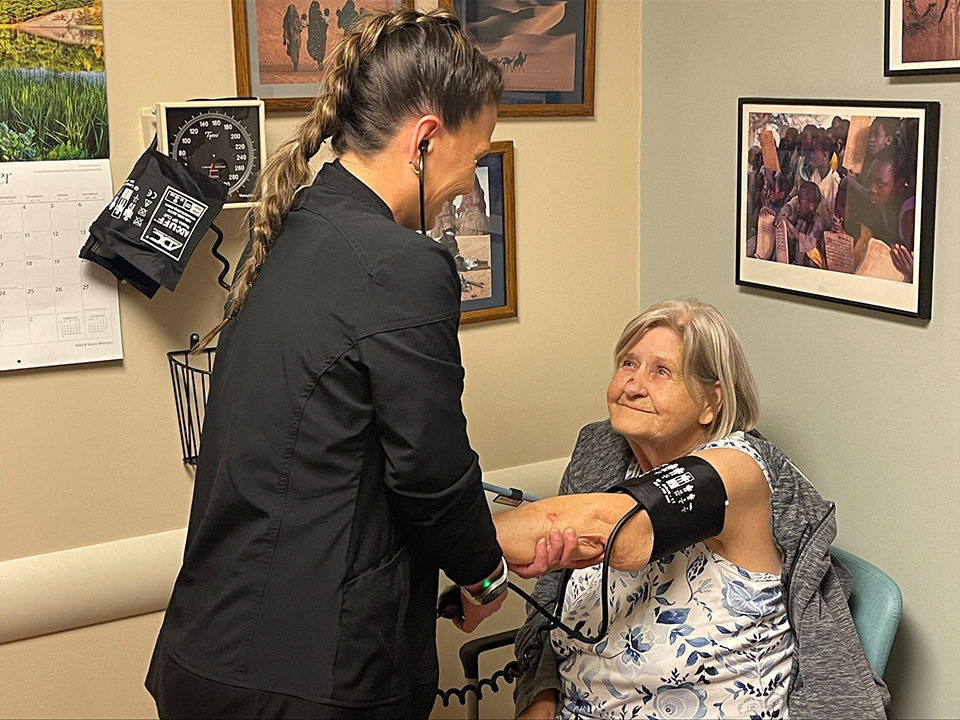Empowering Patients Improves COPD Outcomes
October 23, 2025
Story highlights
- Our patients with COPD are learning to manage their symptoms at home and spending less time in the emergency department
- Through the COPD program, value clinics successfully reduced emergency department use by 5.8% from 2023 to 2024
- With the help of her primary care team, Pat Vanover, age 78, used her action plan and tool kit, avoiding emergency department visits when her COPD flared up
Meet Eileen “Pat” Vanover, age 78. In 2023, Pat visited the emergency department five times for complications of her chronic obstructive pulmonary disease, also known as COPD.
This caught the attention of her primary care team at Gerber Hospital Multispecialty Clinic - Fremont. They determined Pat could benefit from a new approach to treating COPD ― a program that includes meeting with a clinical pharmacy specialist.

Clinical pharmacy specialists cover various aspects of care with the patient:
- Improving inhaler technique
- Managing COPD triggers
- Helping with medication affordability
- Educating them on their COPD action plan
- Issuing an exacerbation tool kit
Pat’s doctor recommended she make an appointment with a care manager as well as a clinical pharmacy specialist, like Christina Inteso, who works with primary care practices.
Christina explained that patients are referred to the COPD program through emergency visits or if a patient scores high on a COPD assessment test in the office.
“That tells us we need to change therapy,” she said.
Phil Waalkes, DO, division chief, primary health, Family Medicine - Zeeland, said: “The COPD project started in our value clinics as part of our ED utilization and hospital readmission reduction work in the population health space. As a department, we appreciated our role in keeping people out of the emergency room and the hospital, but we lacked a structured process to make this happen.”
Initially, nurses from the population health department searched Epic for patients already in their practice with a diagnosis of COPD, chronic bronchitis, emphysema, chronic cough, or asthma. Once verified, internal medicine partnered with respiratory therapy to help get current pulmonary function testing.
The action plan
Together, the patient and the pharmacist create an easy-to-follow plan to manage flare-ups and help prevent future emergency department visits. COPD action plans are a newer tool used in some of our clinics and across the country.
The physician, advanced practice provider, or pharmacist can create the action plan from a template in Epic and print a copy for the patient to take home. It tells the patient what to do based on how they feel, using three color-coded “zones” of green, yellow, and red.
“The patient can check in with themselves,” Christina said. “Based on their symptoms and how they're feeling, it will put them into one of those three categories."
Each category lists possible symptoms along with suggestions for what to do next, which can range from, “Continue taking your medicine” to “Call 911.”
“Having the action plan and knowing how to use it empowers the patient to manage their symptoms at home, day-to-day, when they're not in the office with us,” Christina said.
The tool kit
Pat left her appointment with an action plan, an exacerbation tool kit, and instructions on how to use them. “I use a lot of medicine and inhalers. Sometimes they can change quite a bit and can be hard to keep track of. Everyone in the office helps me remember what I need to take,” she said.
The tool kit, also called an exacerbation kit, empowers patients to have at home some of the same medicine they would receive if they went to the hospital, such as a steroid or antibiotic.
“This is a departure from the past, but well-vetted in the pulmonary world to be a safe and effective treatment plan to keep people out of the ED and hospital,” Dr. Waalkes said.
Education from her care team helps Pat understand when to use the medicine, when to call her doctor, and when to go to the hospital based on her action plan.
The team currently working on outcome measures hopes to see it expand in the near future.
“Not every clinic has a population health RN, care manager, or pharmacist to help in the process,” Dr. Waalkes said. “But everyone can educate their patients on home care and rescue therapies.”
Throughout 2024, Pat made use of her tool kit and exacerbation kit. That year, she only went to the emergency department once.
“I don’t want to go to the emergency room if I don’t have to,” Pat said. “I felt like I was going a lot, but not so much now. I just call the office and they get me in or they get me my kit, which really helps.”
5.8% reduction in emergency visits
Through the COPD program, value clinics successfully reduced emergency department use by 5.8% from 2023 to 2024, which was a primary goal since the value clinics began.
At the same time across the country, emergency department use of patients with these conditions increased by 0.9% (results observed when population is risk adjusted for complexity).

